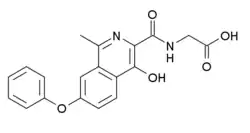Roxadustat
Roxadustat (INN, trade name Evrenzo in Japan) is a drug which acts as a HIF prolyl-hydroxylase inhibitor and thereby increases endogenous production of erythropoietin, which stimulates production of hemoglobin and red blood cells. It was investigated in clinical trials for the treatment of anemia secondary to chronic kidney disease.[1][2] Due to its potential applications in athletic doping, it has also been incorporated into screens for performance-enhancing drugs, as it has already been detected being used illicitly by athletes despite not having yet been approved for medical use.[3][4][5] Roxadustat received its first global approval in China on 17 December 2018 for the treatment of anaemia caused by CKD in patients who are dialysis-dependent.[6] Roxadustat is reported to increase VEGF, a signal protein that can activate tumor growth[7] and also is considered to cause pulmonary hypertension.[8] Recently, in phase 3 trial conducted at 29 sites in China, roxadustat treatment was found to cause hyperkalemia, i.e., increase in serum potassium, and metabolic acidosis in patients.[9]
 | |
| Clinical data | |
|---|---|
| Other names | FG-4592, ASP1517, AZD9941 |
| ATC code | |
| Identifiers | |
| |
| CAS Number | |
| PubChem CID | |
| DrugBank | |
| ChemSpider | |
| UNII | |
| KEGG | |
| CompTox Dashboard (EPA) | |
| ECHA InfoCard | 100.245.356 |
| Chemical and physical data | |
| Formula | C19H16N2O5 |
| Molar mass | 352.346 g·mol−1 |
| 3D model (JSmol) | |
| |
| |
See also
References
- Provenzano R, Besarab A, Sun CH, Diamond SA, Durham JH, Cangiano JL, et al. (June 2016). "Oral Hypoxia-Inducible Factor Prolyl Hydroxylase Inhibitor Roxadustat (FG-4592) for the Treatment of Anemia in Patients with CKD". Clinical Journal of the American Society of Nephrology. 11 (6): 982–91. doi:10.2215/CJN.06890615. PMC 4891748. PMID 27094610.
- Becker K, Saad M (April 2017). "A New Approach to the Management of Anemia in CKD Patients: A Review on Roxadustat". Advances in Therapy. 34 (4): 848–853. doi:10.1007/s12325-017-0508-9. PMID 28290095.
- Beuck S, Schänzer W, Thevis M (November 2012). "Hypoxia-inducible factor stabilizers and other small-molecule erythropoiesis-stimulating agents in current and preventive doping analysis". Drug Testing and Analysis. 4 (11): 830–45. doi:10.1002/dta.390. PMID 22362605.
- Buisson C, Marchand A, Bailloux I, Lahaussois A, Martin L, Molina A (March 2016). "Detection by LC-MS/MS of HIF stabilizer FG-4592 used as a new doping agent: Investigation on a positive case". Journal of Pharmaceutical and Biomedical Analysis. 121: 181–187. doi:10.1016/j.jpba.2016.01.029. PMID 26808067.
- Eichner D, Van Wagoner RM, Brenner M, Chou J, Leigh S, Wright LR, et al. (November 2017). "lmplementation of the prolyl hydroxylase inhibitor Roxadustat (FG-4592) and its main metabolites into routine doping controls". Drug Testing and Analysis. 9 (11–12): 1768–1778. doi:10.1002/dta.2202. PMID 28378453.
- Dhillon S. Roxadustat: First Global Approval.Drugs (2019) 79:563–572 https://doi.org/10.1007/s40265-019-01077-1
- Zhou M, Hou J, Li Y, Mou S, Wang Z, Horch RE, et al. (April 2019). "The pro-angiogenic role of hypoxia inducible factor stabilizer FG-4592 and its application in an in vivo tissue engineering chamber model". Scientific Reports. 9 (1): 6035. Bibcode:2019NatSR...9.6035Z. doi:10.1038/s41598-019-41924-5. PMC 6465281. PMID 30988335.
- Cygulska K, Wejner-Mik P, Plewka M, Figiel Ł, Chrzanowski Ł, Kasprzak JD (May 2019). "Roxadustat: another drug that causes pulmonary hypertension? Report of first human case". Polish Archives of Internal Medicine. 129 (5): 344–345. doi:10.20452/pamw.4445. PMID 30758318.
- Chen N, Hao C, Peng X, Lin H, Yin A, Hao L, et al. (September 2019). "Roxadustat for Anemia in Patients with Kidney Disease Not Receiving Dialysis". The New England Journal of Medicine. 381 (11): 1001–1010. doi:10.1056/NEJMoa1813599. PMID 31340089.